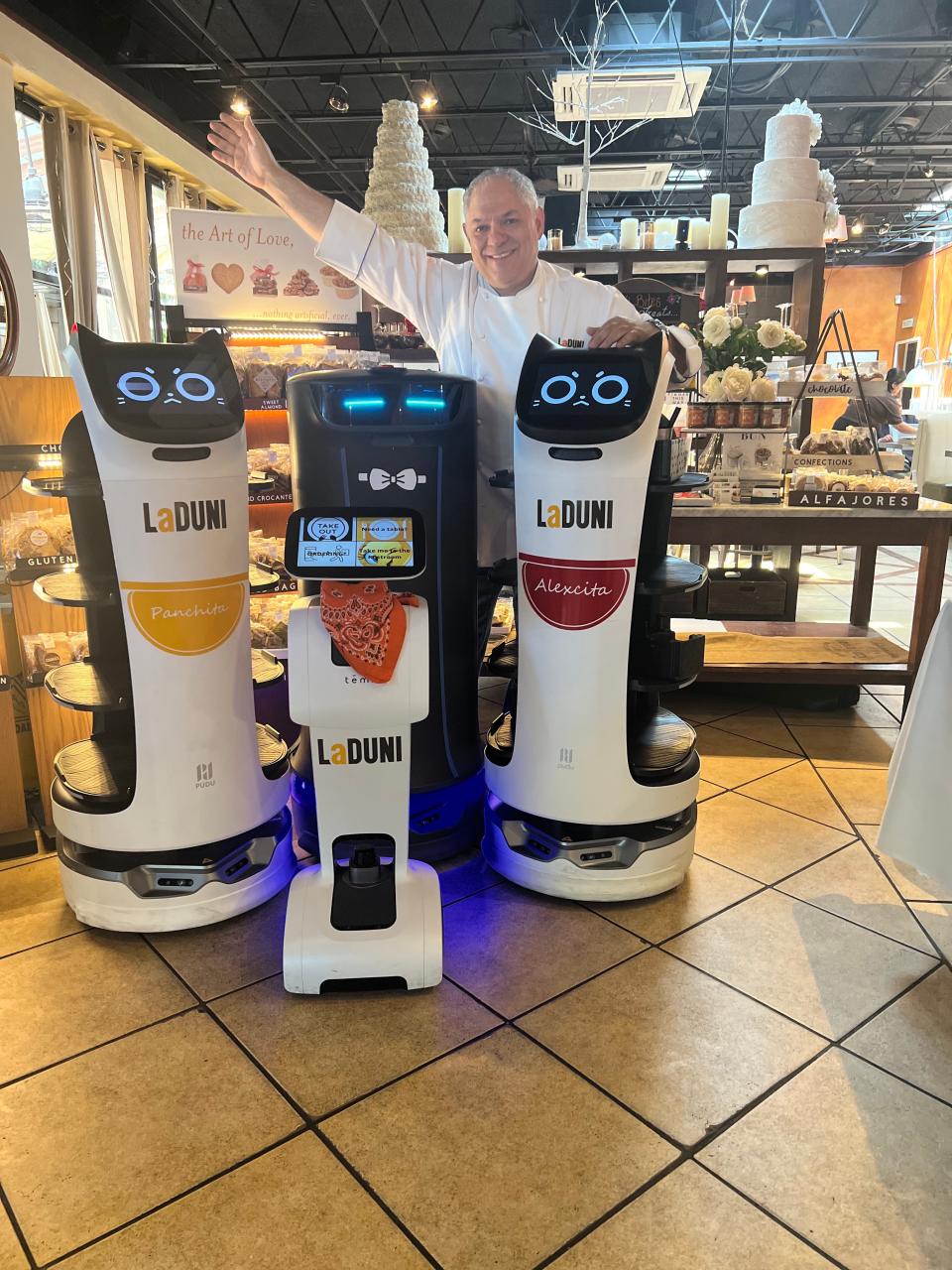US economy on brink of recovering pre-COVID-19 job numbers, but more than half of industries lag
The U.S. is on pace to recover all 22 million jobs wiped out in the COVID-19 recession as early as July, but the milestone will obscure sharp differences among industries and an economy transformed by the crisis.
Industries that have thrived during a pandemic that has kept Americans working and playing at home for long stretches – such as e-commerce, technology and professional services – already have reached or topped their pre-COVID-19 payrolls.
Computer programming is 10.3% above its February 2020 staffing level. Courier services are up by 29.6%.
Sectors clobbered by the crisis, including restaurants, theaters and spectator sports, will take longer to heal as COVID-19 fades, experts say.
RETURN TO OFFICE: It took returning to the office to realize how working from home changed me
UNEMPLOYMENT: Economy adds 428,000 jobs in April even as COVID-19 cases edge higher, unemployment is unchanged at 3.6%
Some job categories unlikely to fully rebound
Jobs reliant on in-person shopping and previous business routines may never return to their prior peaks as COVID-19-related shifts become ingrained, experts say. Americans are increasingly working from home, shopping online and conducting business meetings and conferences via Zoom. Those trends are expected to partly reverse as the health crisis eases but won’t go away.
The number of employees at janitorial services is still 5.5% lower than it was in February 2020. Clothing store staffs are down by 15.8%. And convention and trade show organizers are off by 44%.
Industries centered on business travel, office buildings and much of brick-and mortar retail likely won’t return to pre-COVID-19 employment levels by 2025, according to a report this month by the Burning Glass Institute, which conducts research on the future of work and workers.
“The pandemic wasn’t just a business disruption,” says institute President Matt Sigelman. “It was a force in changing both consumer behavior and business behavior.”
READY, NOT READY: Shaky Wi-Fi, a stained blazer, forgotten lunch: Going back to the office was harder than expected
DRUG OBSTACLES: Substance abuse rose in the pandemic. That may explain our slow to return to work, study shows
Total job recovery expected by summer, but it's uneven
Overall, the nation lost 14.4% of its 152.5 million jobs in the spring of 2020 but is now just 0.8% below its pre-COVID-19 employment, an achievement that doesn't account for growth in the working-age population.
But the rebound has been decidedly uneven. Of 557 industries analyzed by Burning Glass, 327, or 57%, still have payrolls below their pre-pandemic level. One in 6 is still down at least 10%, according to the research group.
By summer, when the U.S. is expected to return to pre-crisis payrolls, only about half the industries will have fully recovered, predicts Burning Glass Chief Economist Gad Levanon.
Among broader industry sectors, transportation and warehousing – think Amazon, DoorDash and UPS – leads, with payrolls already 11.6% above its previous high as it caters to a home-centered economy.
Text with the USA TODAY newsroom about the day’s biggest stories. Sign up for our subscriber-only texting experience.
At the other end of the spectrum, leisure and hospitality – which includes restaurants and bars – has regained 6.8 million lost jobs, the most among all sectors, but it’s still 8.5% below its February 2020 level.
Some industries are beset by meager sales because of changes in how people live and work. Customer demand at restaurants, however, has surged beyond its pre-pandemic pace as Americans venture back to old routines. Yet eateries can’t find enough workers amid lingering COVID-19-related labor shortages, delaying the industry's recovery.
“It’s become a competition (for workers) between industries,” says economist Dante DeAntonio of Moody’s Analytics.
HIGH GAS PRICES EVERYWHERE: The average gas price is above $4 in every state. How long will they continue to rise?
RENT SURGE: Manhattan rental prices surge on pent-up demand
Worker shortages and shifts
Fields loosely considered blue-collar because they typically don’t require bachelor’s degrees – such as warehousing, restaurants, retail, manufacturing and construction – are offering big pay increases and other perks as they vie for a limited pool of workers, DeAntonio says. Many employees, he says, are still hesitant to go back to in-person work settings.
Some of those blue-collar workers are earning certificates or college degrees and switching to white-collar industries that allow them to work remotely at more flexible hours, DeAntonio says. About 55% of job changes recorded by LinkedIn last year have been from one industry to another.
DeAntonio reckons leisure and hospitality will eventually reclaim all its lost jobs, but it could take a year or more.
By spring of last year, Dallas-based La Duni Café saw sales climb 40% above its pre-COVID-19 level, but owner Espartaco Borga couldn’t find workers. Most of his former servers and busboys snared gig economy jobs at Uber, DoorDash and other services that let them work as much, or as little, as they wish.
“It’s impossible to compete with that,” Borga says, even though his servers can earn $75,000 to $100,000 a year. “I can’t give them a 1-hour shift, a 2-hour shift.”
Last summer, Borga began leasing five robots at a cost of $200 a month. The robots, multilevel tray carts topped by a computer monitor, deliver food and drinks to tables, clear dirty dishes and escort patrons to tables. The robot platoon allows Borga to serve his 100-seat restaurant with three waiters during a busy shift instead of the 12 he had before the pandemic.

He has no plans to replace the robots with humans once the labor shortage eases. “It is the future,” he says.
A closer look at the broad sectors that have regained all lost jobs:
Transportation and warehousing
Employment: 11.6% above pre-COVID-19 level.
The industry is the biggest beneficiary of a nation hunkered down at home for much of the past two years as consumers ordered goods online. Besides the 30% rise in courier jobs, warehouse and storage positions have leaped 35%.
Professional and business services
Employment: 3.4% above pre-COVID-19 level
The sprawling sector includes industries benefiting from a strong economy and employee preferences for remote work, including accounting, legal and management consulting firms. It’s also riding the explosion of e-commerce and all things digital as computer programming and system design companies add lots of jobs.
As general manager of a casual restaurant in Los Angeles, Sean Sarreal, 31, enjoyed leading a team and ensuring “everything is running smoothly.” But when the pandemic decimated restaurant visits in 2020, his $55,000 annual salary was slashed to $20 an hour and he lost his benefits.
He also grappled with a steady stream of employee COVID-19 cases. “It was hard to keep morale up,” he says.

Although he was assured his salary would be reinstated when business bounced back, he didn’t know how long that would take. “And even if it does come back, it’s going to be a lot different,” Sarreal says he reasoned.
So late last year, Sarreal, an avid gamer, took a 14-week programming boot camp offered by Coding Dojo. Now he’s earning an $80,000 salary developing user interfaces for banks and investment companies to manage their clients’ money. It’s allowed him to buy a new car and move from his parents’ house to his own apartment.
Yet other industries in professional and business services are still well below their pre-pandemic staffing, including office management, event planning and travel agencies. The latter is 40.5% off its pre-pandemic employment.
Entire Productions, a San Francisco-based corporate event management company, staged 650 events in 2019 but COVID-19 slashed the total to 200 mostly virtual events in 2021, says CEO Natasha Miller.
Miller has cut her staff from a dozen to seven. Business is starting to pick up. She estimates she’ll produce 270 mostly in-person events this year but COVID-19 spikes could force some cancellations.
“Do I staff up?” she asks. “If people start canceling and postponing events, I’ll be stuck.”

Miller wrestles with both weaker demand and worker shortages. If she could hire three or four more employees, she says she could produce 300 to 350 events this year but many have left the industry.
“It’s been challenging,” she says, adding she believes revenue and jobs will return by the end of 2023.
Retail
Employment: 1.8% above pre-COVID-19 level.
The pandemic accelerated a longer-term shift from shopping at physical stores to online. But the overall numbers mask big disparities among subsectors.
Employment is still down 8% at electronic and appliance stores and 4.2% at department stores. Many Americans need fewer outfits for the office and buy what they do need online. But it’s up 3.4% at grocery stores and 15.5% at warehouse clubs and supercenters, which have benefited from home-centered lifestyles.
Information
Employment: 1.7% above pre-COVID-19 level.
Information offers another split-screen picture. Movie production, data processing and internet publishing companies have added workers. Newspapers, telecommunications companies and broadcast TV and radio outlets are still behind, continuing longer-run trends as information and entertainment has moved online.
Financial activities
Employment: 0.8% above pre-COVID-19 level.
Banks have lost employees as services have gone digital. But mortgage brokers and investment firms added workers as both the housing and stock markets surged during the pandemic.
Construction
Employment: 0.5% above pre-COVID-19 level.
The industry has faced dire worker shortages but benefited from the COVID-19-sparked housing boom.
Here are broad sectors that are still below their pre-pandemic staffing levels:
Mining and logging
Employment: 10.6% below pre-COVID-19 level
Coal mining continues to lose workers as coal-fired power plants shutter. Oil and natural gas drilling is close to recovering the jobs lost as prices crashed early in the pandemic. But producers were slow to invest in new drilling until prices soared in recent months.
Leisure and hospitality
Employment: 8.5% below pre-COVID-19 level
The sector has steadily recovered as Americans gradually return to dining out, travel, theater, museums, spectator sports and amusement parks. Overall, it should fully recover as the pandemic fades further, but worker shortages will prolong the comeback, DeAntonio says.
And certain industries may lag. Americans are visiting hotels for pleasure but a smaller business travel industry could weigh on occupancy for the longer run. And it’s unclear to what extent hotels that have cut back housekeeping will continue to do so even after COVID-19 eases, DeAntonio says.
Government
Employment: 3% below pre-COVID-19 level
State and local governments have struggled to attract workers, says Julia Pollak, chief economist at ZipRecruiter. They can’t keep pace with sharp private-sector pay increases during the crisis because of contracts, balanced-budget laws and more rigid pay systems, she says.
Education and health services
Employment: 1.7% below pre-COVID-19 level.
Health care has rebounded but is still below its pre-crisis level. While employment at physicians’ offices has more than recovered, hospitals and nursing homes have had a tough time attracting workers after many grappled with health worries and burnout during the pandemic.
Utilities
Employment: 1.5% below pre-COVID-19 level
Payrolls are normally steady at power plants and water and sewage systems. But like other blue-collar fields, the sector has struggled to draw workers to in-person environments, DeAntonio says. And many baby boomers are retiring.
Manufacturing
Employment: 0.4% below pre-COVID-19 level.
Although manufacturers have struggled to hire workers partly because of the pandemic, they have added about 600,000 jobs since early 2021 and are close to reclaiming pre-crisis staffing.
Americans’ purchases of cars, furniture, appliances and TVs during the health crisis has been a boon for the industry.
This article originally appeared on USA TODAY: Jobs and economy: Some industries top pre-COVID payrolls. Others lag.

 Yahoo Movies
Yahoo Movies 
